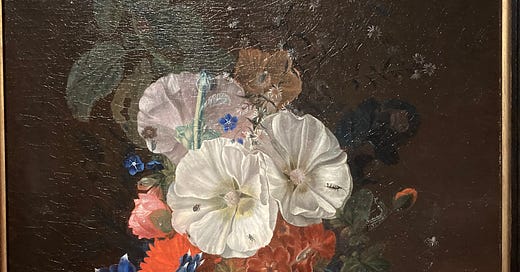There’s a word in Japanese, aware (ah-WAH-ray), that expresses the sadness and delight we feel at the beauty of things that will soon fade; things like the fragile pink of cherry blossoms, the fleeting soft smell of a baby’s head, or the feathery white of cirrus clouds high in a windy sky.
When John, Emily, and I traveled to the Netherlands this spring, I aptly experienced a moment of aware in a cemetery. A cemetery is a wonderful place to understand the fleeting beauty of life, and how fragile we all are. But the aware I experienced was not because of the graves. Rather it was because many of the graves had flowers on them. Ok, you say, that’s normal, so what? So these flowers weren’t in their most robust moment, instead dying lilies or wilting roses drooped over the headstones, their petals scattered on the grave below. Ok, so somebody didn’t clean up the dying flowers. So what? So, these flowers couldn’t be cleaned up, they were affixed to the graves; they were metal flowers, cast in the ephemeral moment of death…forever. The paradox of it made me stop and pause and gaze at the strange beauty of a dying iron lily. I suddenly found myself sad that roses and lilies must die, but equally delighted that artists had caught those moments of death in a deathless way.
Paintings of still-life, especially flowers, are alluring to me because they also capture this paradoxical form of aware. Emily and I visited the Lakenhal museum in Leiden where one painting in particular gripped me in its ephemeral beauty: Bloemstilleven (Flower Still Life) by Catharina Backer, 1700. The flowers in the bouquet are not roses or lilies, which tend to hold their color and shape for a while after being cut. After some searching (I’m not the best flower identifier), I believe Backer painted hollyhocks and gentians. These flowers are tender and delicate, and only last an hour or two in water before wilting. It seems an insurmountable task to paint an entire oil painting in an hour or two while the blossoms are actively fading. In the days before cameras, an artist would have to be very skilled at painting quickly, as well as have a killer sketching ability and a vivid imagination. Catharina Backer is clearly so skilled. Her flowers are lovely and fresh, seemingly just cut. You can almost see the bending and nodding of the blossoms as a moth and various other insects wander across the delicate petals, drawn to their invisible perfume. But there’s a fragility to the bouquet, a knowledge that the beautiful arrangement will fade and die in a few hours. Backer catches that ephemeral beauty of aware, and yet holds it for us. Like the paradoxical iron roses and lilies whose death will last generations, Backer’s bouquet will bloom in delicacy for many, many more years.




Love this, I can almost smell the flowers in the painting!